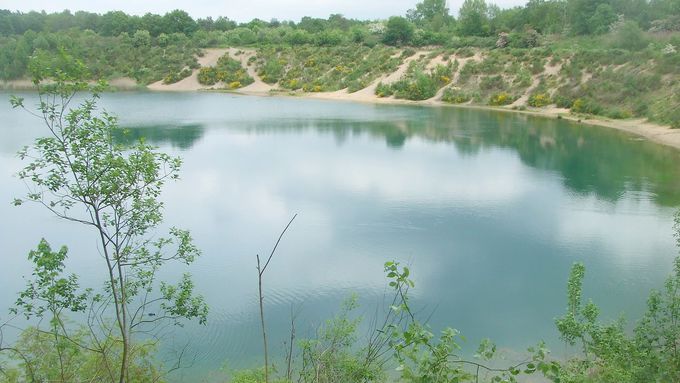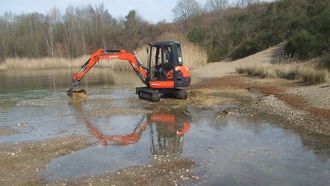Through the use of a mini-excavator over a length of 240 metres of the water’s edge more than 20 new temporary small waterbodies with sparse vegetation were created. © Holger Sticht, BUND NRW
main content
News
04.04.2018
New spawning grounds for the natterjack toad in the nature reserve “Dellbrücker Heide”
In the framework of the Integrated LIFE Project „Atlantic Region DE“ conservation measures for the endangered natterjack toad (Bufo calamita) have been implemented recently in the nature reserve “Dellbrücker Heide”, to prevent the imminent extinction of the decreasing population which occurs there. The threatened Amphibian species is one of the ten focus species of the LIFE IP which is funded by the EU and managed cooperatively in the federal states of North Rhine-Westphalia and Lower Saxony.
The Dellbrücker Heide, a part of the natural region “Bergische Heideterrasse“, is an important refugium for species of unwooded habitats such as sandy xeric grasslands and dry sand heaths with Calluna and Genista. A former gravel excavation is part of the 40-hectare nature reserve. One of the last populations of the natterjack toad within the region can be found there as well. The actual habitat of the natterjack toad – xeric grasslands and heathlands – adjoin to the edge of the water-filled excavation. For reproduction, however, the natterjack toad is dependent on flat, sun-exposed and therefore rapidly warming pools as spawning grounds. These typically occur only temporarily and are free from fish, as they dry up during periods of low precipitation or low groundwater levels. In contrast to most other Amphibian species, the natterjack toad is well adapted to such temporarily existing waters due to its long spawning season from mid-April until mid-August and the short development time of tadpoles of only four weeks. Their original spawning grounds were small waterbodies in open floodplains which emerged after the annual flood. However, due to human settlement developments, by the 20th century at the latest these primary habitats have completely disappeared, so that areas like the Dellbrücker Heide are the last remaining secondary habitats.
In the area of the gravel excavation, suitable spawning grounds have been heavily reduced and devaluated in the past years through succession and illegal recreational use. More than 20 new temporary small waterbodies with sparse vegetation – a type of habitat which is endangered and protected by law in Germany – have been created as part of the LIFE IP’s actions through the use of a mini-excavator over a length of 240 metres of the water’s edge. This now provides optimal conditions for the small remaining population of the natterjack toad to reproduce and stabilize sufficiently. Furthermore, other endangered species occurring in this area will also benefit from the new small waterbodies, e.g. the yellow-winged darter (Sympetrum flaveolum) and the small bluetail (Ischnura pumilio). Corresponding synergetic effects are expected for the habitat type "Oligotrophic to mesotrophic standing waters with vegetation of the Littorelletea uniflorae and/or of the Isoeto-Nanojuncetea", one of the focus habitat types of the integrated LIFE project.
The implementation of this conservation measure was carried out by the district government of Münster in cooperation with the district government of Cologne, the lower nature conservation authority of the City of Cologne and the regional association of Friends of the Earth Germany in North Rhine-Westphalia (BUND-NRW).
Further information regarding the implementation area (only in German):





